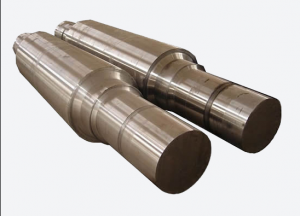Hinge shaft forging is a kind of mechanical parts made by forging process, mainly used to connect and support rotating parts, common in various mechanical equipment hinged parts. Its material is usually made of high-strength steel, such as alloy structural steel, carbon structural steel, etc., to ensure that it has good mechanical properties and wear resistance. The forging process can make the internal structure of the material more dense, improve the strength and durability of the hinge shaft forging.
In addition, according to the specific application scenario and working conditions, hinge shaft forgings may also choose stainless steel, copper alloy, aluminum alloy and other materials for forging. Stainless steel has good corrosion resistance and oxidation resistance, suitable for hinge shaft forgings that need to be exposed to moisture or corrosive environment for a long time; Copper alloys and aluminum alloys have light weight and good thermal conductivity, and are suitable for occasions where weight and heat dissipation need to be reduced.

In the forging process, the raw material goes through process steps such as heating, deformation and cooling to form a hinge shaft forging with the desired shape and size. Forging can not only improve the strength and hardness of the material, but also improve its organization and performance, so that the hinge shaft forging has better wear resistance, impact resistance and fatigue resistance.
Hinge shaft forgings are widely used in various mechanical equipment, such as automobiles, ships, aerospace, engineering machinery and other fields. They play an important role in connecting, supporting and transmitting torque, and are one of the key parts to ensure the normal operation of mechanical equipment and extend the service life.
In order to meet the needs of different fields and working conditions, the design and production of hinge forgings usually need to follow strict standards and specifications. This includes specific requirements for its size, shape, material properties, surface quality and so on. The manufacturer needs to customize the production according to the drawings or technical requirements provided by the customer to ensure that the quality of the hinge shaft forging meets the relevant standards and customer requirements.
In terms of quality control, hinge shaft forgings need to undergo strict inspection and testing. This includes the testing of its dimensional accuracy, material composition, mechanical properties, surface defects, etc., to ensure that its quality meets relevant standards and regulations. In addition, the forging process needs to be monitored and controlled to ensure the stability and reliability of the production process.
With the continuous development of the manufacturing industry and the continuous progress of technology, the production process and material selection of hinge forgings are also constantly innovative and improved. For example, the use of advanced forging technology and equipment can improve production efficiency and product quality; The development of new materials can improve the mechanical properties and corrosion resistance of hinge shaft forgings. The application of intelligent and automatic technology can realize the automation and intelligent control of the production process, improve production efficiency and reduce costs.
In short, hinge shaft forging as an important part of mechanical equipment, its quality and performance have an important impact on the normal operation and service life of the equipment. Therefore, in the design and production process, it is necessary to fully consider its application scenarios and working conditions, select the appropriate materials and processes, and ensure that its quality meets the relevant standards and customer requirements.
